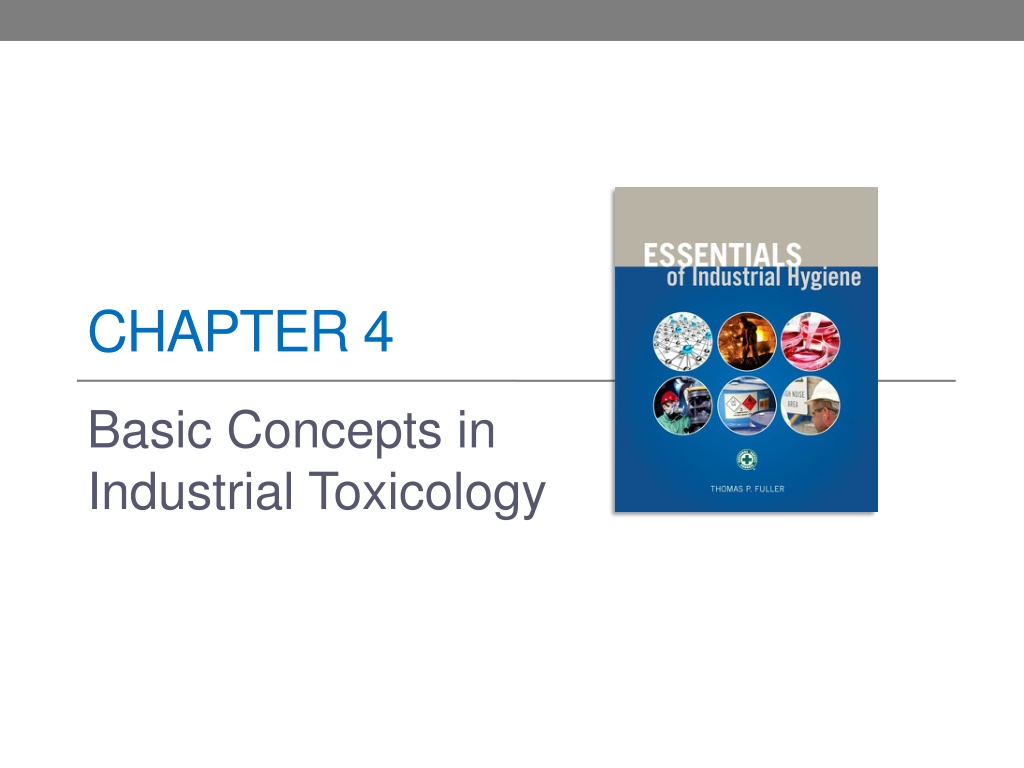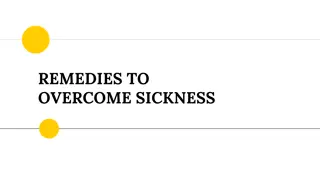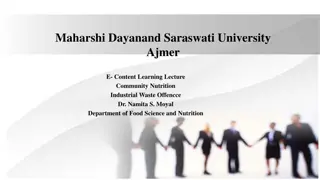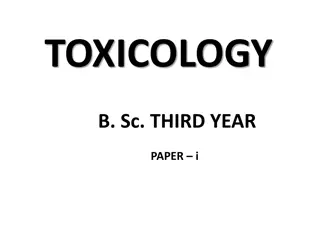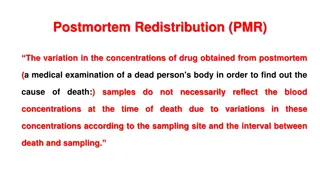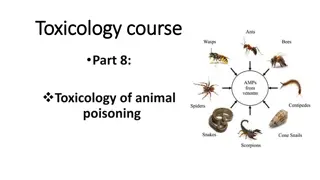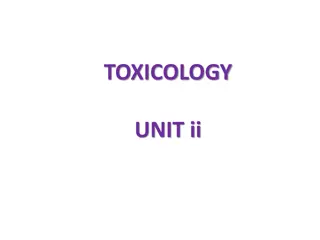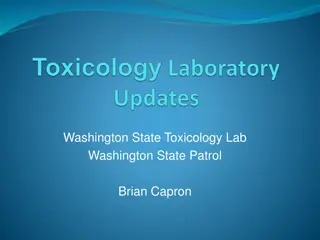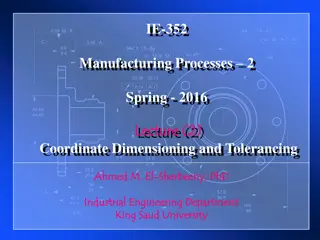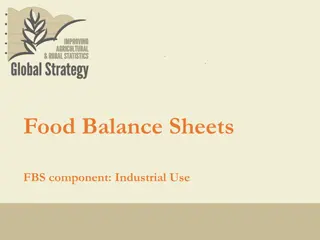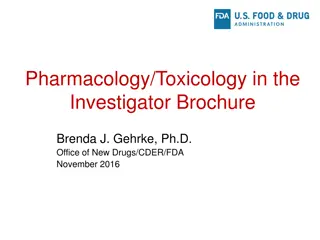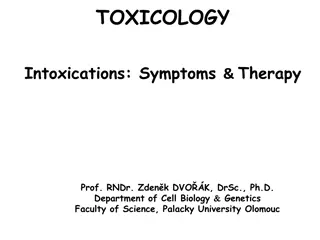Understanding Basic Concepts in Industrial Toxicology
Industrial toxicology is a vital field that studies the effects of various agents on organism health through mechanisms of action, toxicokinetics, and more. It explores toxic chemical absorption, distribution, metabolism, and elimination, as well as toxic effects on major organ systems. Learn about key events in the mode of action, establishing mechanisms, biomarkers of effects, and weight of evidence criteria in toxicology studies.
Download Presentation

Please find below an Image/Link to download the presentation.
The content on the website is provided AS IS for your information and personal use only. It may not be sold, licensed, or shared on other websites without obtaining consent from the author. Download presentation by click this link. If you encounter any issues during the download, it is possible that the publisher has removed the file from their server.
E N D
Presentation Transcript
CHAPTER 4 Basic Concepts in Industrial Toxicology
Learning Objectives Define the study of toxicology and explain why it is important to the practice of industrial hygiene. List different mechanisms and modes of toxic chemical action and the various methods used to measure and document toxicity. Explain various criteria for causation of toxic effects. Describe toxicokinetics. Identify and list routes of toxic agent exposure in the human body. Understand toxic chemical absorption, distribution, metabolism, and elimination. Explain the concept of dose response. Describe the toxic effects typical in the major organ systems.
Toxicology A broad field that studies the effects of chemical, biological, and physical agents on the health of an organism. Includes studies at the molecular basis of the biological response up to and including evaluations at the cellular, tissue, organ, organ system, and whole body levels. Integrates several areas of science, including chemistry, biology, physiology, and pathology.
Mechanisms of Action Detailed descriptions of the process involved in an agent s toxic effects, from initial exposure to the development of adverse reactions
Key Events in a Mode of Action An empirically observable step that is a necessary element of the mode of action or is a biologically based marker for such an element
Mechanism of Action and Mode of Action
Establishing Mechanisms of Action Epidemiological studies Laboratory studies Animal studies
Weight of Evidence Strength Consistency Specificity Temporality of events Coherence and plausibility Dose-response relationship
Toxicokinetics The ways chemicals are taken into the body, move throughout the body, and are removed from the body The behavior of a chemical is reflected in a series of processes including absorption, distribution, metabolism, and elimination (ADME).
Routes of Exposure Ingestion Inhalation Dermal Percutaneous
Absorption Internal dose: the amount of an agent absorbed into the body Dependent on the properties of the chemical such as lipid solubility, molecular size, and concentration gradients
Rate of Chemical Absorption,Tmax Indicated by the time it takes for the chemical to reach peak blood concentrations after exposure
Percent Bioavailability The amount of an agent recovered from excreta divided by the total dose The amount left behind in the body to cause damage Useful when extrapolating toxicity data from one route of exposure to another
Distribution How a chemical moves through the body once it is absorbed Partition coefficients: ratios at equilibrium between the blood and varying tissues of the body describe agent s affinity for a particular tissue or organ
Metabolism The process by which the body transforms a molecule, be it a toxicant, nutrient, or normal physiological (i.e., endogenous) chemical or molecule For toxicants, metabolism often serves to transform the agent into a form that is more easily removed from the body = biotransformation
Elimination How the body removes agents from the body urine feces respiration sweat
Biological Half-Life The time it takes for the concentration of a chemical in the body to decrease by half
Liver Toxicity First-pass metabolism One of the most common sites of toxicity because it processes many chemicals, including those whose metabolic products are toxic
Kidney Toxicity The kidney plays vital roles in removing metabolic waste, regulating body fluid volumes, maintaining electrolyte balance, and ensuring proper body pH
Kidney Toxicity (cont.) (Source: 7activestudio/iStock)
Lung Anatomy Upper respiratory tract Trachea Bronchi Alveoli
Lung Function Measures Total Lung Volume (TLV) the total volume of air the lung can hold Vital Capacity (VC) the amount of air moved into and out of the lungs when taking the largest possible breath Tidal Volume (TV) the amount of air moved into and out of the lungs into a typical resting breath
Health Effects Edema an accumulation of fluids in the pulmonary tissues Fibrosis lung tissue scarring decreases the surface area available for gas exchange and causes the lungs to become less compliant (stiffer), making it harder to draw air into the pulmonary region of the lungs Emphysema destruction of the gas exchange surfaces of the alveoli, causes inefficient exchange of gases and results in larger pockets filled with air Cancer
Gas Exchange (Source: ttsz/iStock)
Neurotoxicity Toxic chemicals interfere with the transmission of numerous signals in the body that control motion as well as autonomous body functions.
Neurotoxicity Signals Pupil dilation and altered breathing rates. Other signs of autonomic dysfunction include tremors or convulsions, gait abnormalities, decreased grip strength, or a decreased ability to remain upright. Pathological examinations can discover changes in axon length, decreases in the amount of myelin surrounding axons, or deaths of neuronal cells.
Neurotoxicity Signals (cont.) (Source: blueringmedia/iStock)
Reproductive and Developmental Toxicity Reduced ability to reproduce Damage to offspring Disruption of germ development Impacts on the embryo and fetus
Immunotoxicity Toxic agents that affect the immune system through functional immunosuppression, which prevents the immune system from protecting the body
Skin Toxicity Nonallergic irritation Allergic contact dermatitis Corrosive chemical burns Chemical-induced photosensitivity
Carcinogenesis and Genotoxicity Neoplasia originates from inheritable changes in cell growth that lead to the loss of normal control processes. Classified as begin or malignant Metastasis the movement of neoplastic cells to locations beyond the primary site of origin The term cancer refers to malignant neoplasms
